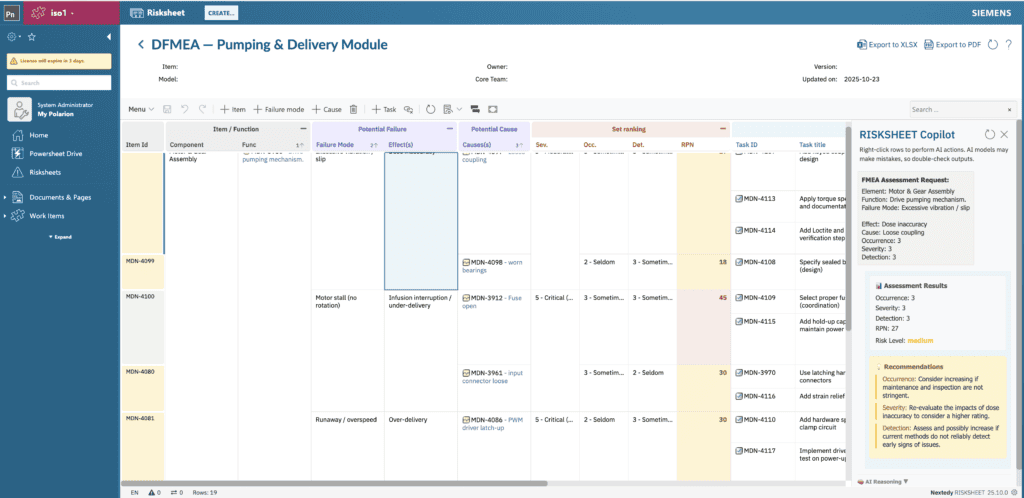Preface: Why This Document Matters
This document introduces RISKSHEET Copilot, an AI assistant designed not to be “interesting,” but to be genuinely useful by solving the core challenges of your daily work. We believe there is a better way to conduct safety analysis.
Read on to discover how you can:
- Stop reinventing your FMEA; reuse past knowledge.
- Reduce arguments & get consistent risk ratings.
- Complete safety analysis in a fraction of the time.
- Connect risks directly to requirements and controls.
- Get smart, auditable suggestions, not generic chat.
This isn’t about replacing the critical judgment of engineers; it’s about empowering it.
In the current tech landscape, AI is everywhere. The pressure to integrate artificial intelligence into every product is immense. That’s why we’ve been asked, more than once, why we haven’t rushed AI features into our products.
Our answer is simple: Because we wanted to solve real problems, not just demonstrate a capability.
Anyone who has spent hours in a Failure Mode and Effects Analysis (FMEA) workshop knows the challenges. It’s not the final calculation of the RPN that consumes time and energy; it’s the intense, often repetitive, human analysis required to get there.
The FMEA Grind: Why a Powerful Method Feels Painful
The most significant challenges in safety analysis aren’t about technology; they’re about human collaboration, consistency, and cognitive load.
- The Brainstorming Bottleneck: Identifying all potential failure modes and their causes is the most time-consuming part of any FMEA, often taking up 30-40% of the total effort. Teams reinvent the wheel, struggling to recall lessons from past projects. The same failure—a “seal leak,” “leakage at joint,” or “gasket failure”—gets described differently, shattering any hope of reuse or pattern recognition.
- The Core Problem: Subjectivity: The biggest qualitative weakness of FMEA is its reliance on subjective judgment. Two expert teams can look at the same failure and assign different Severity, Occurrence, and Detection ratings. This inconsistency isn’t a minor flaw; it means RPNs become unreliable, making it impossible to compare risks across projects and leading to the misprioritization of critical safety work.
- The Disconnect from Reality: Too often, the FMEA becomes a static, document-driven exercise—a compliance checkbox rather than a living engineering tool. Ratings for occurrence and detection are rarely updated with real-world test results or field data, making the analysis feel disconnected from the product it’s meant to protect.
This is precisely why we built RISKSHEET Copilot. It’s not a chatbot. It’s a contextual assistant designed to attack these core FMEA challenges head-on.
How Copilot Provides Structured, Contextual Assistance
RISKSHEET Copilot is deeply integrated into your workflow, understanding the difference between a HARA, a DFMEA, and a PFMEA. It reads the context of the row you are working on and provides intelligent, actionable suggestions right where you need them.
1. Tackling Inconsistency and the Brainstorming Bottleneck
Instead of starting from a blank slate, the Copilot acts as your team’s institutional memory. For a given failure mode, it can suggest potential causes by searching your project’s existing knowledge base. This doesn’t just save time; it enforces a shared vocabulary, ensuring that a “loose coupling” is always called a “loose coupling,” which makes your data analyzable and reusable.
2. Bringing Objectivity to Subjective Ratings
To combat inconsistent ratings, the Copilot can perform an FMEA Assessment. It provides an independent, AI-driven evaluation of your Severity, Occurrence, and Detection ratings based on the context of the failure. This “second opinion” helps teams calibrate their analysis, challenge inherent biases, and drive toward more consistent, defensible risk scoring.
3. Grounding Analysis in Your System’s Reality
To bridge the gap between analysis and implementation, the Copilot can suggest existing control and mitigation measures directly from your own requirements database. By linking a failure mode to a specific design control or verification test, it ensures the FMEA is not an isolated document but an integrated part of your engineering lifecycle.
Validated for Trust, Not Rushed for Hype
Why are we launching with a validation phase? Because in regulated industries, a tool must be reliable, auditable, and genuinely helpful. A gimmick that produces plausible but incorrect results is a liability.
We are working with a limited group of organizations to refine the Copilot’s suggestions, enhance its reasoning, and ensure it seamlessly accelerates—rather than complicates—the risk management lifecycle. Our flexible AI framework allows us to configure the Copilot for different methodologies, ensuring its suggestions are always relevant to your specific process.
Join Us in Shaping the Future of Safety Analysis
We believe AI, when applied with purpose, can transform safety analysis from a tedious, subjective exercise into a dynamic, data-driven, and more effective engineering discipline. RISKSHEET Copilot is our first major step in making that vision a reality.
If you are tired of the FMEA grind and want to see what context-aware AI assistance looks like in real-world workflows, we invite you to reach out.
Interested in RISKSHEET Copilot? Contact us to discuss participation in our validation program and schedule a demonstration.



